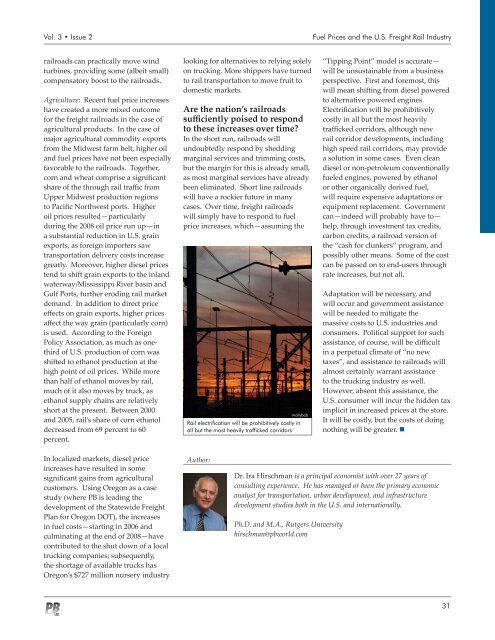ECONOMIC FORECASTING REVIEW - Parsons Brinckerhoff
ECONOMIC FORECASTING REVIEW - Parsons Brinckerhoff
ECONOMIC FORECASTING REVIEW - Parsons Brinckerhoff
Create successful ePaper yourself
Turn your PDF publications into a flip-book with our unique Google optimized e-Paper software.
Vol. 3 • Issue 2<br />
Fuel Prices and the U.S. Freight Rail Industry<br />
railroads can practically move wind<br />
turbines, providing some (albeit small)<br />
compensatory boost to the railroads.<br />
Agriculture: Recent fuel price increases<br />
have created a more mixed outcome<br />
for the freight railroads in the case of<br />
agricultural products. In the case of<br />
major agricultural commodity exports<br />
from the Midwest farm belt, higher oil<br />
and fuel prices have not been especially<br />
favorable to the railroads. Together,<br />
corn and wheat comprise a significant<br />
share of the through rail traffic from<br />
Upper Midwest production regions<br />
to Pacific Northwest ports. Higher<br />
oil prices resulted—particularly<br />
during the 2008 oil price run up—in<br />
a substantial reduction in U.S. grain<br />
exports, as foreign importers saw<br />
transportation delivery costs increase<br />
greatly. Moreover, higher diesel prices<br />
tend to shift grain exports to the inland<br />
waterway/Mississippi River basin and<br />
Gulf Ports, further eroding rail market<br />
demand. In addition to direct price<br />
effects on grain exports, higher prices<br />
affect the way grain (particularly corn)<br />
is used. According to the Foreign<br />
Policy Association, as much as onethird<br />
of U.S. production of corn was<br />
shifted to ethanol production at the<br />
high point of oil prices. While more<br />
than half of ethanol moves by rail,<br />
much of it also moves by truck, as<br />
ethanol supply chains are relatively<br />
short at the present. Between 2000<br />
and 2005, rail’s share of corn ethanol<br />
decreased from 69 percent to 60<br />
percent.<br />
looking for alternatives to relying solely<br />
on trucking. More shippers have turned<br />
to rail transportation to move fruit to<br />
domestic markets.<br />
Are the nation’s railroads<br />
sufficiently poised to respond<br />
to these increases over time?<br />
In the short run, railroads will<br />
undoubtedly respond by shedding<br />
marginal services and trimming costs,<br />
but the margin for this is already small,<br />
as most marginal services have already<br />
been eliminated. Short line railroads<br />
will have a rockier future in many<br />
cases. Over time, freight railroads<br />
will simply have to respond to fuel<br />
price increases, which—assuming the<br />
mollybob<br />
Rail electrification will be prohibitively costly in<br />
all but the most heavily trafficked corridors<br />
“Tipping Point” model is accurate—<br />
will be unsustainable from a business<br />
perspective. First and foremost, this<br />
will mean shifting from diesel powered<br />
to alternative powered engines.<br />
Electrification will be prohibitively<br />
costly in all but the most heavily<br />
trafficked corridors, although new<br />
rail corridor developments, including<br />
high speed rail corridors, may provide<br />
a solution in some cases. Even clean<br />
diesel or non-petroleum conventionally<br />
fueled engines, powered by ethanol<br />
or other organically derived fuel,<br />
will require expensive adaptations or<br />
equipment replacement. Government<br />
can—indeed will probably have to—<br />
help, through investment tax credits,<br />
carbon credits, a railroad version of<br />
the “cash for clunkers” program, and<br />
possibly other means. Some of the cost<br />
can be passed on to end-users through<br />
rate increases, but not all.<br />
Adaptation will be necessary, and<br />
will occur and government assistance<br />
will be needed to mitigate the<br />
massive costs to U.S. industries and<br />
consumers. Political support for such<br />
assistance, of course, will be difficult<br />
in a perpetual climate of “no new<br />
taxes”, and assistance to railroads will<br />
almost certainly warrant assistance<br />
to the trucking industry as well.<br />
However, absent this assistance, the<br />
U.S. consumer will incur the hidden tax<br />
implicit in increased prices at the store.<br />
It will be costly, but the costs of doing<br />
nothing will be greater. •<br />
In localized markets, diesel price<br />
increases have resulted in some<br />
significant gains from agricultural<br />
customers. Using Oregon as a case<br />
study (where PB is leading the<br />
development of the Statewide Freight<br />
Plan for Oregon DOT), the increases<br />
in fuel costs—starting in 2006 and<br />
culminating at the end of 2008—have<br />
contributed to the shut down of a local<br />
trucking companies; subsequently,<br />
the shortage of available trucks has<br />
Oregon’s $727 million nursery industry<br />
Author:<br />
Dr. Ira Hirschman is a principal economist with over 27 years of<br />
consulting experience. He has managed or been the primary economic<br />
analyst for transportation, urban development, and infrastructure<br />
development studies both in the U.S. and internationally.<br />
Ph.D. and M.A., Rutgers University<br />
hirschman@pbworld.com<br />
31
















